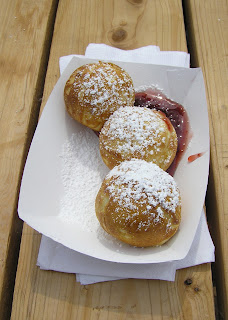
Æbleskiver
Danish Hearth, $3
As populations shift and tastes change, the mark of the Scandinavian cultures that shaped many of neighborhoods on Seattle's north side seems to be fading: the Van de Kamp's windmill in lower Queen Anne is a distant memory, the Scandinavian Bakery building is now a Thai restaurant, and Scandinavian Specialties is Ballard's last remaining source for Nordic imports.
But the frenzy of the Nordic Heritage Museum's " Viking Days" celebration suggested that while those cultures may be less obvious today, they are neither gone nor forgotten. The Museum's parking lot was crowded with Viking reenactments and historical displays, demonstrations of traditional crafts, retail stalls, and plenty of food. In addition to the usual beer and grill tents, there were regional "hearths," booths dedicated to the foods of a particular country.
The Danish Hearth's line was longest and slowest, but it gave customers a front row seat as expert volunteers cranked out the only item on the menu: æbleskiver. Cooked in special cast iron skillets with dome-shaped indentations, these spherical pancakes are served with jam and a sprinkling of powdered sugar (above).


One volunteer worked non-stop to meet the demand for fresh batter (left), which was then passed down the line to the cooks stationed at portable stoves (right).


Each new batch started with a hemisphere's worth of batter (left). As the underside of the batter skinned over, the cook used a skewer to lift the cooked section partway out of the pan, allowing more of the uncooked batter to contact the skillet.


Little by little, the hemispheres became bowls, then Pac-Men (left), then spherical golden-brown æbleskiver.
At the Icelandic Hearth, there were thin slices of vínarterta ($1), sawed off of a towering stack of cardamom shortcake layered with spicy prune jam. The recipe for "Vienna cake" dates back to at least the mid-19th century, when European pastry chefs began to have access to refined white "Vienna flour." It's been a popular cake for Icelandic celebrations ever since, with even fancier rainbow-striped versions made by using a variety of different jams. After the cake is baked and constructed it is wrapped tightly, then set aside to age for up to two months.




No comments:
Post a Comment